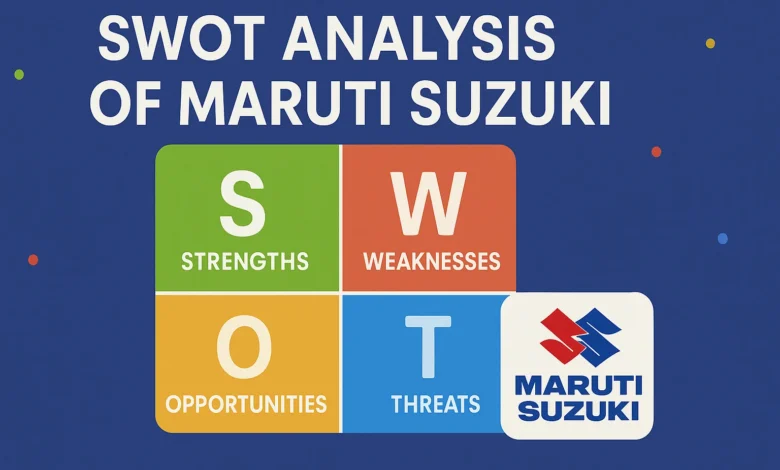SWOT Analysis of Maruti Suzuki (2025): Strengths, Challenges &Growth Outlook of India’s Auto Leader
Explore the complete SWOT analysis of Maruti Suzuki in 2025. Discover what drives India’s largest carmaker, where it faces roadblocks, and the opportunities and threats shaping its future in a changing auto market.

For millions of Indian families, buying their first car often starts with one name—Maruti Suzuki. From the iconic Maruti 800 to the ever-popular Swift, WagonR, and Brezza, the brand has built a reputation for affordability, reliability, and nationwide reach.
But the Indian automobile market in 2025 isn’t what it used to be. With EVs gaining ground, fuel prices fluctuating, and customer preferences shifting toward premium and feature-rich cars, even an industry leader like Maruti Suzuki can’t rely on its past glory.
In this blog, we’ll explore a complete SWOT analysis of Maruti Suzuki—covering its key strengths, internal weaknesses, emerging market opportunities, and growing external threats.
Whether you’re an auto enthusiast, MBA student, investor, or planning your next car purchase—this deep dive will give you a clear, strategic view of India’s most loved carmaker.
Let’s begin with a quick overview of the company that dominates Indian roads.
Also read: Complete SWOT Analysis of Hyundai – A Deep Dive into the Korean Auto Giant
Learn AI & Digital Marketing,
Pay Fees After Placement
- ✅ Minimal Admission Fees
- ✅ No Loan or Income Sharing Agreement
- ✅ 100% Placement Support
- ✅ ISO & Govt Registered Certificate
- ✅ Practical 3+1 Months Duration
Get a free counseling call. We’ll guide you through learning, certification, and job placement.
Request a Free Call Back
Takes less than a minute.
Company Overview of Maruti Suzuki
Maruti Suzuki India Limited, originally established in 1981 as a joint venture between Maruti Udyog Ltd. and Suzuki Motor Corporation (Japan), is India’s largest passenger vehicle manufacturer. Headquartered in New Delhi, Maruti Suzuki has been a key player in India’s auto revolution for over four decades.
As of 2025:
-
Market Share: ~42% in the passenger vehicle segment
-
Production Capacity: 2.5+ million units annually
-
Popular Models: Swift, Baleno, WagonR, Ertiga, Brezza, Alto, Dzire
-
Exports: Over 100 countries including Africa, Latin America, and Southeast Asia
-
New Focus Areas: Electric Vehicles (eVX platform), CNG, hybrid models, and connected car technologies
With over 4,000+ sales outlets and 3,700+ service centers, Maruti Suzuki has unmatched penetration across India—from metro cities to remote rural villages.
Its promise? “Reliable mobility for every Indian.”
What is a SWOT Analysis?
A SWOT analysis is a simple yet powerful tool used to assess a company’s strategic position by examining four key dimensions:
-
Strengths – What gives the company a competitive edge
-
Weaknesses – Internal limitations or gaps
-
Opportunities – Market trends or areas for expansion
-
Threats – External challenges or risks that may impact growth
For an automotive giant like Maruti Suzuki, a SWOT analysis in 2025 is more relevant than ever. The Indian auto market is shifting—EVs are rising, customers want feature-rich, safer vehicles, and government policies are reshaping the industry.
This analysis will help us understand where Maruti Suzuki stands—and what it must do to drive ahead in this fast-changing landscape.
Also read: Complete SWOT Analysis of Hyundai – A Deep Dive into the Korean Auto Giant
Strengths of Maruti Suzuki
Despite increasing competition, Maruti Suzuki continues to lead India’s automobile industry—and for good reason. Its dominance is built on a foundation of trust, value, and scale that few others can match.
Let’s explore the key strengths that keep Maruti ahead of the curve in 2025:
1. Unmatched Market Leadership
Maruti holds a commanding ~42% share of the Indian passenger vehicle market, making it the undisputed leader. Its wide portfolio caters to budget-conscious, first-time buyers—still the largest segment in India.
This leadership gives it negotiating power, brand pull, and deep consumer insight.
2. Extensive Service & Sales Network
With over 4,000+ showrooms and 3,700+ service centers, Maruti reaches even the remotest parts of India. For customers in Tier-2 and Tier-3 cities, service availability and affordability are deal-breakers—and Maruti delivers both.
3. Affordable, Fuel-Efficient Vehicles
From Alto and WagonR to Swift and Dzire, Maruti’s cars are known for their low maintenance, excellent mileage, and resale value—attributes Indian buyers prioritize the most.
Maruti also leads the CNG vehicle segment, which continues to grow due to rising fuel prices.
4. Strong Brand Recall and Trust
Ask any Indian about their first car, and chances are it was a Maruti. This emotional and cultural connection, built over decades, is a massive intangible asset for the company.
It’s not just a car brand—it’s a part of India’s middle-class journey.
5. Localization & Manufacturing Strength
Maruti sources most of its components locally, reducing production costs and supply chain disruptions. With multiple plants in Haryana and Gujarat, it enjoys economies of scale unmatched by many global rivals.
Competitor Comparison Table – 2025 Snapshot
| Brand | Market Share (PV) | EV Portfolio | Avg Price Range | Service Reach | India Manufacturing |
|---|---|---|---|---|---|
| Maruti Suzuki | ~42% | CNG, EV (in dev) | ₹4L – ₹15L | 3,700+ centers | High (multi-plant) |
| Tata Motors | ~14% | EV, CNG | ₹5L – ₹25L | 1,500+ centers | High |
| Hyundai | ~15% | EV, Petrol | ₹6L – ₹25L+ | 1,300+ centers | Medium |
| Mahindra | ~9% | EV (SUV) | ₹10L – ₹30L | 1,000+ centers | Medium |
Note: Data compiled from FY24–25 market reports and company filings.
Maruti Suzuki’s core strength lies in trust, reach, and affordability—a powerful combination that continues to fuel its leadership.
Weaknesses of Maruti Suzuki
While Maruti Suzuki leads the market in terms of sales and brand recall, it also carries a few internal limitations that could hinder its long-term growth—especially as consumer expectations and market dynamics evolve rapidly.
Let’s take a closer look at the key weaknesses:
1. Slow Entry into the EV Market
In a world rapidly moving toward electric mobility, Maruti is lagging behind competitors like Tata and MG. Its first EV (based on the eVX platform) is still under development, with no clear product in market as of mid-2025.
This late start could cost Maruti early-mover advantage in India’s growing EV segment.
2. Limited Premium Vehicle Presence
Maruti has struggled in the ₹12–20 lakh+ price range. Despite launching NEXA as a premium retail channel, models like Ciaz, XL6, and Grand Vitara have seen only moderate success.
Consumers in this range often shift to Hyundai, Kia, or even Skoda and Mahindra for better features, safety, and build quality.
3. Perception as a “Budget Brand”
While affordability is its strength, it also limits brand aspiration. Young, urban buyers often view Maruti as basic or outdated compared to more tech-savvy or style-driven alternatives.
4. Tech & Safety Feature Lag
Maruti’s cars often miss out on segment-leading features like:
-
6 airbags as standard
-
ADAS (Advanced Driver Assistance Systems)
-
Connected car tech
This has become a growing concern in India’s competitive, feature-obsessed market.
5. High Dependence on ICE Models
Despite fuel price volatility and government pressure for cleaner mobility, a majority of Maruti’s sales still come from petrol or CNG engines. Its slow shift to hybrids or full electrification puts its long-term sustainability at risk.
These weaknesses don’t erase Maruti’s strengths—but they highlight areas where the brand must evolve quickly to stay ahead.
Opportunities for Maruti Suzuki
As India’s mobility landscape transforms, Maruti Suzuki has a lot to gain—if it adapts fast. With its reach, infrastructure, and brand trust, the company is in a great position to lead not just in ICE, but in the next generation of sustainable, tech-driven mobility.
Let’s look at the key opportunities ahead:
1. Electric Vehicle (EV) Expansion
Maruti is set to launch its first electric SUV—the eVX—by the end of 2025. With government subsidies, tax benefits, and a rising EV-conscious audience, this could open a massive new revenue stream.
Its parent company Suzuki is also investing in battery and EV R&D, which could fast-track future launches.
2. Growth in Tier-2/3 & Rural Markets
With increasing income levels, demand for four-wheelers is growing beyond metros. Maruti’s wide service reach, affordable financing, and rural brand recall make it a natural winner in these emerging regions.
Customized variants, small SUVs, and compact hybrids can further solidify its rural dominance.
3. CNG and Hybrid Leadership
While other brands push EVs, Maruti already dominates the CNG vehicle segment, which is growing in urban fleet markets (Ola, Uber, delivery apps).
Its move into mild hybrids and flex-fuel vehicles can help bridge the gap until full EV infrastructure matures.
4. Export Market Expansion
Maruti is steadily increasing its footprint in Africa, Latin America, the Middle East, and Southeast Asia. Its compact, fuel-efficient cars match the needs of these cost-sensitive markets.
With global demand for small cars rising, exports could become a much larger revenue channel.
5. Shared Mobility & Fleet Partnerships
As more users opt for subscription models or shared ownership (Zoomcar, Revv), Maruti can enter partnerships for leasing, fleet sales, or EV-based ride-sharing models.
These new mobility trends offer recurring revenue and brand visibility among younger users.
If Maruti aligns its product roadmap, pricing, and innovation strategy, it can retain its mass-market edge while entering high-growth future segments.
Threats to Maruti Suzuki
Maruti Suzuki may be the king of the Indian roads, but the road ahead isn’t free from bumps. With consumer preferences shifting, new players entering the arena, and the rise of clean mobility, Maruti faces some serious external challenges.
Let’s look at the biggest threats that could slow down its momentum:
1. Intense Competition in EV and Tech Segments
Tata Motors, MG, Hyundai, and BYD are aggressively pushing EVs with connected features, long ranges, and fast-charging networks.
Maruti, without a single EV in the market yet, risks losing tech-savvy and eco-conscious buyers, especially in urban markets.
2. Fuel Price Volatility and Emission Norms
With fuel prices constantly fluctuating and the Indian government tightening emission norms (BS6 Phase 2), Maruti’s reliance on petrol and CNG vehicles could backfire.
The transition to cleaner alternatives must speed up, or it risks regulatory and consumer backlash.
3. Changing Buyer Preferences
Today’s consumers expect:
-
6 airbags minimum
-
Infotainment with Android Auto/Apple CarPlay
-
Sunroofs, digital clusters, and ADAS
Brands like Kia and Hyundai are setting these as benchmarks—even in compact SUVs. Maruti risks being seen as outdated if it doesn’t evolve fast.
4. Supply Chain Disruptions
Semiconductor shortages, lithium cell sourcing, and rising input costs are global issues affecting auto production. Maruti’s high-volume production model can face significant delays or cost pressure if supply chains remain unstable.
5. Global Brands Eyeing India
Chinese, Korean, and even European brands are eyeing India’s budget and EV segments. If companies like BYD, SAIC, or Renault-Nissan scale production and undercut on price, Maruti’s cost advantage could shrink.
To remain the top choice, Maruti will need to not just adapt to disruption—but lead it.
Strategic Insights & Key Takeaways
Maruti Suzuki has long been the default choice for Indian car buyers—thanks to its unbeatable combination of affordability, service reach, and trusted reliability. But 2025 presents a different challenge: the rules of the game are changing.
Here’s what this SWOT analysis tells us:
-
Strengths like brand loyalty, a vast network, and cost leadership keep Maruti rooted as the market leader.
-
But weaknesses—like delayed EV adoption, limited premium appeal, and lagging features—must be addressed quickly.
-
Opportunities lie in EV launches (eVX), rural expansion, exports, and fleet partnerships—if Maruti can act boldly.
-
At the same time, threats from tech-first competitors, shifting regulations, and evolving customer expectations require it to reinvent how it defines value.
To thrive over the next decade, Maruti must go beyond affordability and embrace innovation, electrification, and aspiration.
Conclusion
Maruti Suzuki has been more than just a car company in India—it has been a symbol of trust, practicality, and first-time ownership dreams.
But as the Indian auto market shifts gears toward electrification, digital features, and sustainability, Maruti finds itself at a turning point.
The SWOT analysis of Maruti Suzuki in 2025 reveals a company with deep strengths—but also with urgent areas to evolve.
Its dominance won’t disappear overnight, but to maintain leadership, Maruti must accelerate its EV plans, improve tech offerings, and redefine its brand perception.
The next phase of Indian mobility will be shaped not just by price—but by purpose, performance, and progress. And Maruti has everything it takes to lead—if it acts boldly.
FAQs – SWOT Analysis of Maruti Suzuki
1. What is Maruti Suzuki’s biggest strength?
Its unmatched market share, extensive service network, and strong brand trust across India—especially in rural and Tier-2/3 markets.
2. Why is Maruti behind in EV adoption?
Maruti has taken a cautious approach to EVs, citing infrastructure and affordability gaps. Its first electric car (eVX) is expected to launch by late 2025.
3. How does Maruti compare with Tata and Hyundai in 2025?
Tata leads in affordable EVs, Hyundai in premium features and tech. Maruti dominates in volume, affordability, and rural reach—but needs to catch up in innovation and safety features.
4. Is Maruti planning more premium vehicles?
Yes, Maruti is expanding its NEXA lineup with models like the Grand Vitara and Invicto. However, it still faces stiff competition from brands offering more features in the ₹10L+ range.





